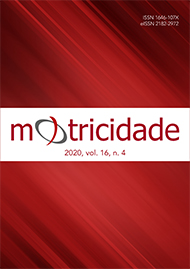Acute physiological responses during a Brazilian endurance triathlon race
DOI:
https://doi.org/10.6063/motricidade.20701Abstract
Triathlon is one of the most flourishing sports in the world. This study aimed to analyze the acute effects of physiological markers and subjective perception variables in amateur trained athletes. Participated in the present study 8 male endurance triathletes with race experience. The injury markers and oxidative stress parameters were investigated in the blood plasma and measured at baseline and post-race. Heat, comfort, and humidity perception, and Borg ratings of perceived exertion were measured during the baseline, transition area, and post-race. Descriptive and inferential statistics were used with significance set as p<0.05. The variables of injury and muscle fatigue presented a significant increase comparing the baseline and post-race data, CK (p= 0.005; d= 5.7), LDH (p= 0.004; d= 1.3) and lactate (p< 0.001; d= 7.2). It was observed a significant increase in CP (p= 0.021; d= 2.2) and a significant decrease in DPPH (p= 0.002; d= -1.4) in post-race, no significant changes in LP (p= 0.217; d= 0.6) and TT (p= 0.881; d= -0.1) oxidative stress markers was verified. A significant increase (Δ% = 30.95, p = 0.001; d = 6.8) was observed in urine temperature and color (range [1-7], p = 0.039). Even with the significant increase in fatigue, with a significant increase in the injury markers, oxidative stress markers suggested a good antioxidant defense. It was observed an increase in exertion and heat perception, as well as a reduction in heat comfort and skin wetness.
Downloads
Published
Issue
Section
License
The authors of submitted manuscripts must transfer the full copyright to Journal Motricidade / Sílabas Didáticas Editions. Granting copyright permission allows the publication and dissemination of the article in printed or electronic formats, and copyrights start at the moment the manuscript is accepted for publication. It also allows Journal Motricidade to use and commercialise the article in terms of licensing, lending or selling its content to indexation/abstracts databases and other entities.
According to the terms of the Creative Commons licence, authors may reproduce a reasonable number of copies for personal or professional purposes, but without any economic gain. SHERPA/RoMEO allows authors to post a final digital copy (post-printing version) of the article on their websites or on their institutions' scientific repository.


